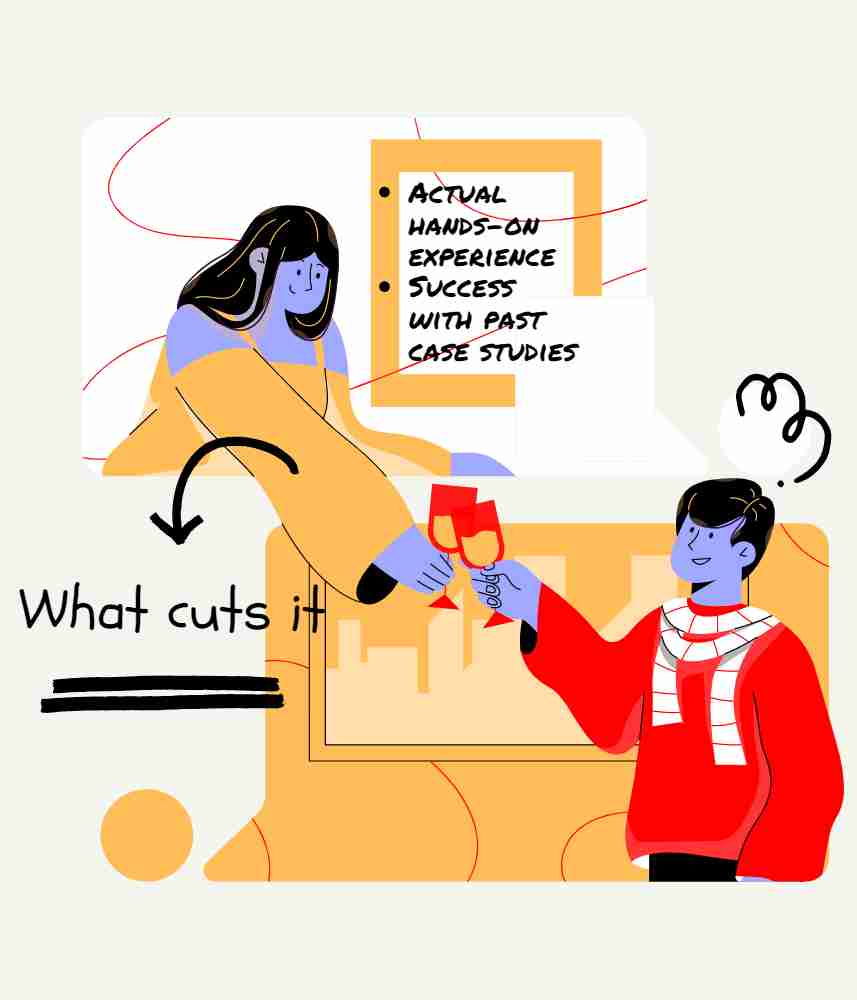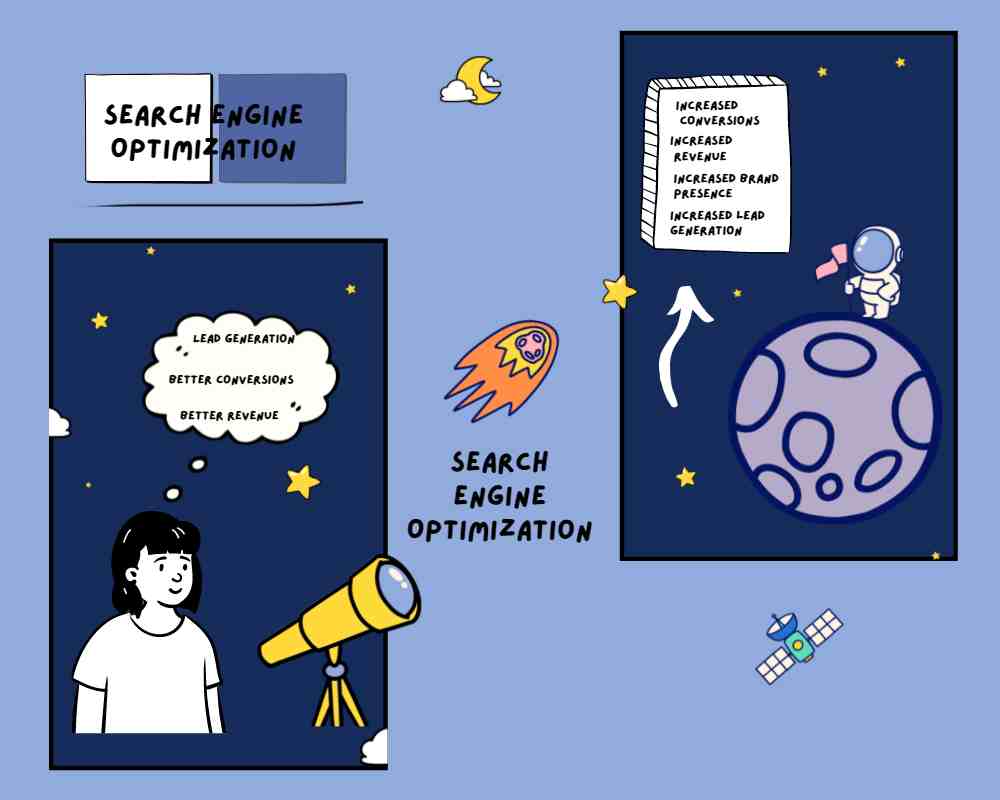So you own an Etsy shop. Like many sellers before you, the challenge with Etsy is getting customers to see (and purchase) the items you’ve poured passion and time into creating.
Etsy says everyone has a fair chance of being seen, but a scroll through listing pages on Etsy is all it takes to see that some sellers get better visibility than others – some sellers have their items on the first page of their categories, and others have it last – so what gives?
How high you rank on Etsy’s listing pages or how much Etsy puts your items in front of buyers depends on two things:
- The level of optimization of your item listing and overall Etsy profile.
- The quality of your service delivery.
Our focus in this Etsy domination guide is the former.
What is SEO
When you search for something online, search engines like Google choose what pages to show based on a set of predetermined factors. Those factors are called ranking factors.
SEO or search engine optimization is ‘optimizing’ a web page to score high marks in the ranking factor assessment. If a web page scores high per Google’s assessment, it is ‘ranked’ higher in search engine results pages above other web pages with a lower score.
This principle of ranking web pages based on a set of factors is also applied on Etsy. And on Etsy, it’s not just any web page, it’s the web page displaying your item for sale. To ‘rank’ pages, Etsy uses a powerful search algorithm to assess listing pages, again using several predetermined factors or ‘ranking factors.’
You get the top spot if your listing page beats every other listing page from sellers selling a similar product/service. If it doesn’t, then you’re pushed down.
The fundamentals of SEO on Etsy
I’ve talked about ranking factors, but what exactly are those ranking factors – the things Etsy’s algorithm assesses when deciding what listing comes first or last – on Etsy.
Etsy’s ‘how search works’ guide dives into what it considers to rank listings on the platform but to summarize:
1. Relevancy
How relevant is your search listing to what buyers on Etsy search for? Relevancy is defined by just how much your listing description, that’s the sum of your naming, tags, attributes and category, match with a buyers’ search query.
The way this works, a buyer searching for, say, ‘personalized neon signs,’ will get Etsy search results with listings that incorporate ‘personalized’ or some variation of the word in their listing description.
If you make the most awesome neon lights but fail to include ‘buyer aware’ keywords (keywords that predict what people search for on Etsy), you’ll miss out on a significant number of buyers provided some other seller on Etsy is being ‘buyer aware.’
2. Conversion
The ultimate goal for Etsy is to process as much sales as is possible on their platform. So naturally, an item listing that gets more buyers to buy or convert will score higher in Etsy’s ranking assessment.
How many buyers reach your listing page compared to how many actually buy your product is your conversion rate.
A high conversion rate signals to Etsy that consumers love your product, and that’s a basis for them to rank you higher than your competitors who might’ve gotten the same exposure but failed to convert as efficiently.
A lot of things go into improving conversion rates, and we’ll dive deeper into them in the dominating part of this guide.
3. Reviews
Reviews play a very important role in SEO on Etsy. I’ll even go as far as to say reviews can make or break your store on Etsy. Good reviews are a sign to show that consumers not only love your product but that they also appreciate the quality of your service delivery.
That’s another way of saying reviews are Etsy’s way to gauge the quality of your overall service offering. Just as Etsy wants to drive sales at all costs, it also wants the best experience possible for customers on its platform.
Reviews are one of the most objective ways it can assess the quality of service delivery, and that’s why they carry so much weight on the platform.
4. Customer retention
Buyers will return to services they love when and if they need the same service in the future.
A high ratio of buyers coming back (or repeat buyers as they’re called) is another way Etsy can deduce that you’re providing excellent service delivery, so this factors into your ranking score as well.
More than anything, your number of repeat buyers depends on your product type and product quality, so it’s not really a tangible search engine optimization factor in the actual sense of the word.
But still, it’s something that affects your ranking, and there are ways to encourage repeat buying.
5. Recency
To give everyone a fair chance, Etsy temporarily boots new listings, so they appear top of specific listing pages on its platform.
Imagine what would happen if new listings never get a chance to show how much they can convert or retain customers; they’d score absolute minimal points in those parts of the ranking assessment and, as such, have unfairly low-ranking scores.
Pushing new listings to the top of listing pages gives everyone a chance to prove themselves, and you can use this feature to your advantage. I’ll talk about how to do that in the dominating through listing optimizations segment of this guide.
At its core, these factors are what drives the Etsy listing algorithm. There are other miscellaneous factors (like IP infringement issues) but most of them are not exactly optimizable or have minimal impact on your listing performance.
I’ll touch upon some in the next section.
Now you know how Etsy scores listing pages, the next step is how to actually improve your score.
1. Dominating through keywords
Keywords are the descriptive terms you use to identify your items on Etsy. They’re keywords because, ideally, they should summarily describe your items in terms that are exact or closely related to terms/phrases buyers use when searching for items like yours.
Optimizing your keywords plays into the relevancy part of improving your ranking score.
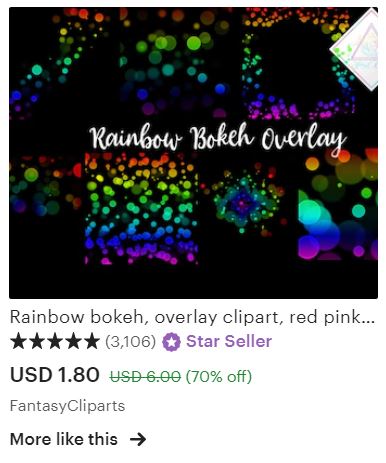
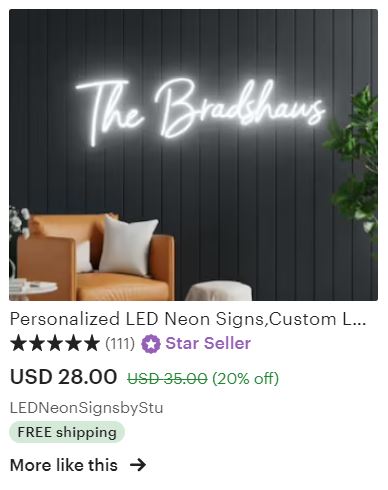
Consider this, some buyers searching for neon lights might not know the actual name of neon lights. What you’ll see is they’ll instead search for things like glowing lights and colored light effects when what they actually want are neon lights.
If you set up an Etsy shop to sell custom neon lights and you don’t attempt to optimize your listings for these keywords, then you might be missing out on a huge market share.
How do you know the terms/phrases or keywords potential buyers use to reach items like yours on Esty? You’ll have to do a keyword research.
✅ Keyword research for Etsy
The key to succeeding with your keyword research is putting yourself in the shoes of your buyers. If you were the average buyer of your product/service, how would you search for said service?
Don’t get lazy, brainstorm.
Notice how I’ve not started my recommendations for how to do a keyword research with referrals to the many Esty keyword finders? Truth is, most of those tools use third party data from other providers, not Etsy itself.
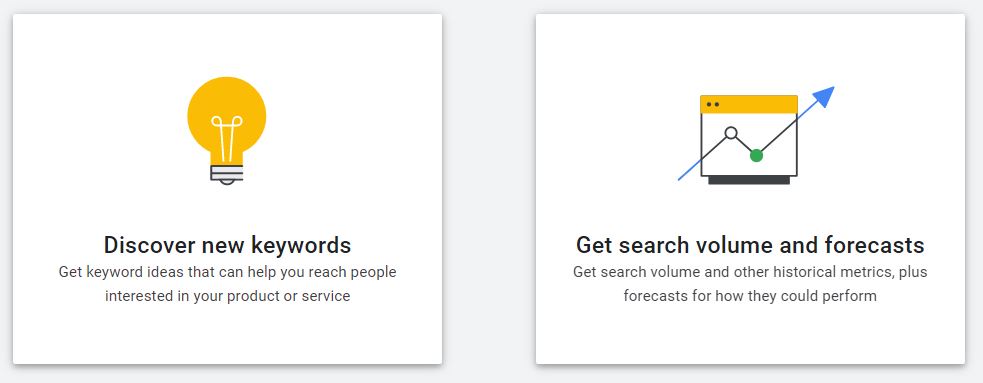
The usual data source is Google Adwords, and that data is mainly for searches on Google, not Etsy, not to mention that data is totally free of charge if you set up a free Adwords account.
Now searches on Google and other search engines can and do mirror Etsy searches, at least to an extent. Meaning keyword ideas from these tools can actually help. The key is to take such keyword data with a grain of salt.
So what’s the end game for keyword research on Etsy:
- Brainstorm
- Skip the paid tools and dive into Google AdWords yourself for inspiration.
- You can also use the Etsy search bar to get an idea of what keywords buyers use;
- Type in a seed keyword, which could be any single word from your preliminary list of keywords and let Etsy’s search autocomplete bring out suggestions.
- Note down suggestions and once again screen them using your better judgement.
- Be cautious with suggested keywords – pick only those that appear highly relevant based on your judgement.
- Make sure to rotate through suggested keywords if sales are not picking up.
Once you’ve successfully populated your keyword list, the next step is to use it to score high points in the Etsy relevance assessment. Here’s how to do that:
✅ Keywords for your listing title
From your keyword research, what do you think is the most likely term or phrase buyers use to get to products and services like yours. Let’s fall back to our neon light example again to illustrate the point.

If our keyword research returned the terms neon lights, colored lights, custom neon signs, neon signs for room, led neon underglow lights, led neon signs, car underglow, neon wall lights, good vibes only neon sign, neon beer signs as the strongest possible keywords for a neon light listing how would you go about cramming all of that into the listing title.
You don’t, instead, you pick the strongest keywords of the bunch and then merge others. Your strongest keywords are those:
- Most relevant to your listing: so for our example, neon wall lights are more relevant than good vibes only neon sign.
- That are relevant but underserved: the ideal keyword for your listing title should not be a direct match of what everyone else has on theirs; it should be a keyword no one else has thought to focus on.
I’ll give you an example.
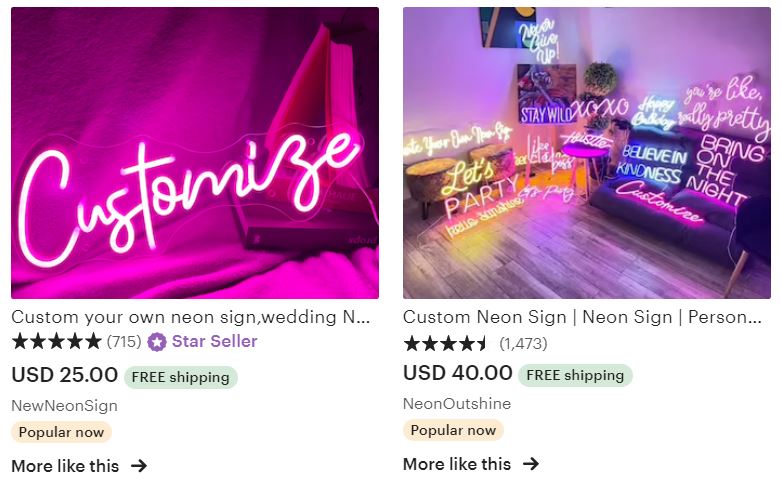
For neon lights, you’ll see listings on Etsy with custom neon signs, custom neon lights and other variations of the phrase as keywords. That’s an overserved keyword phrase.

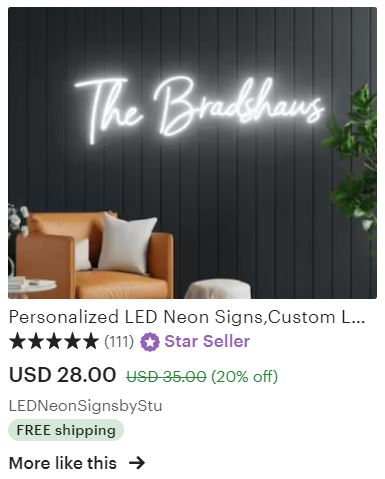
Something like personalized led neon signs, however, that’s kinda unique, and I’ll take you to the Etsy page for the search phrase ‘neon lights.’ Notice how these three listings each spot unique keywords in their listing titles.
Notice also how they seem to be the odd one out in terms of reviews count – other listings, asides from ads, have upwards of 500 reviews. Both are less than a hundred reviews.
Targeting relevant but underserved keywords in your listing title is one objective way to rank your listings higher, even if you don’t score high marks in other ranking factor assessments.
Once you’ve selected your main/strongest keyword phrase, you can then add up auxiliary keywords to make a complete listing title. Etsy allows up to 140 characters for each listing title. Your main keyword should start the listing title, and auxiliary keywords should come after.
Auxiliary keywords are those that fulfil the same requirements of being relevant and underserved only this time, they’re not the strongest, that is, they’re not the most likely phrase buyers use to reach services/products like the ones you offer.
If two auxiliary keywords are similar, you can merge them into one. For instance, led neon signs and led neon underglow lights can be merged into led neon signs & underglow lights.
You can separate each keyword phrase in the title with slashes.
With the listing title, the focus was on the most probable search phrases potential buyers use. For tags, you’re spreading your tentacles to cover everything associated with the product or service you’re selling.
Tags help Etsy draw up relevancy, but in addition, they’re also a way to form associations between products.
Ever noticed how a listing page usually has a ‘you may also like’ and ‘more from this shop’ section? Those sections are populated by other similar product listings from the original seller as well as from other sellers.
Similarity to a particular product is something Etsy figures out by analyzing your listing tags.
You can specify 13 tags for each listing. Ideally, your tags should contain rollover keywords from your keyword research, those that met the relevancy and underserved metrics but were worse off than the keywords that eventually made the cut.

Also, go through the listing pages. Click through as many listings as you can afford, and then try to pick out the listings that make the ‘you may also like’ segments. Scroll down and check out the explore related categories and searches section.
Make a note of keywords in this section that appear on multiple listing pages.
The tags element is one place where following the crowd has its advantages. If you come across an ‘explore related categories and searches’ keyword that appears in the same section for more than three listings related to your product, you should include it in your tags.
✅ Keywords for attributes
Whereas keywords are buyer likely descriptive terms, attributes are the actual descriptive terms used to define the characteristics of your product or service.
For our example neon lights, an attribute could be red, blue, or green under color; or office space, home or art décor under use-case; or abstract, minimalist, or detailed under design; or for living rooms, lounges, bedrooms, or bathrooms under places for use.
With attributes, you’re no longer trying to capture as much search market share as possible, you’re merely describing your item in such a way that it shows up exactly where it’s needed.
Any keyword you use here should be highly relevant. I’ll give an example; if our neon lights are blue colored, then it makes sense to give them the blue color attribute and blue color only.
Adding a red color attribute even when it’s blue might make it appear for red color searches, but since attributes are used by buyers (as filters) to narrow down what they actually want, it’ll be ignored by said buyers, thereby affecting your conversion rating.
That’s not to say you should become extremely conservative with your item attributes. No, when using attributes, make sure to capture as many keywords as possible, only this time be very specific about the keywords you use – they should be highly relevant to whatever product you’re selling.
Our neon lights example can have multiple attribute settings. For instance, we could give it a led neon attribute; a living room, office lounge, kitchen and bedroom attributes because the design allows it to be used in all those places; a minimalist as well as abstract design attribute, because our design is both at the same time.

Attributes are used to define filters for buyers. So to get an idea of what attributes might matter to define your product check out the filters available for products like yours on Etsy search pages.
2. Dominating with listing optimization
Listing optimization is very central to improving your conversion rating, the second-ranking factor we talked about earlier. An optimized listing is a listing that converts or induces buyers to make the purchase, and there are several ways to do this optimization.
Categories on Etsy are like navigation routes for buyers. If you have them set up properly, then it’s easy for buyers to navigate to your product when they need it.
It also means your product will be available at the right place for buyers who might not be looking for your product but need it anyways.
Proper category set-up is putting your product in the exact place on Etsy’s ‘map’ where buyers will expect it to be. So relevancy also matters here.
Let’s go back to our neon light example.
If our lights are decorative neon light, then it makes sense to tag them in the home décor category of the Etsy marketplace.
We can go further with the tagging to tag them as wall décor, and even deeper, wall hangings and under wall hangings, signs. A buyer who’s looking for shiny decorative wall art lands on the home décor category.
Among the options there, they’ll see the wall décor segment, then the wall hangings and eventually the signs segment where our neon lights product lives in Etsy’s market map.
But let’s assume our neon lights were for framing other artworks much like this listing.
Since this is not ready-made wall décor and more of a DIY add-on, its category changes because people who need neon lights for framing are more likely to go to the craft section of Etsy for their needs.
So for this case, the end category is craft supplies and tools as it rightly should.
To get the right category for your product, once again, put yourself in the buyers’ shoes. Where would you go to using Etsy’s map (categories) to find a product/service like yours.
Alternatively, you could just search for similar products and check out their category tagging. That should give you an idea where to start from.
✅ Optimizing your description
Your description is your sales pitch to the intending buyer. You’ve got it right with your title, tags, and categories; now the buyer is on your listing page – you need to make a sale.
One mistake many new Etsy sellers make is to load their descriptions with a gigantic wall of text. I just want to buy a custom neon light; I don’t need to know how you got the inspiration to make this on your soul-searching trip to India.
Keep it simple.
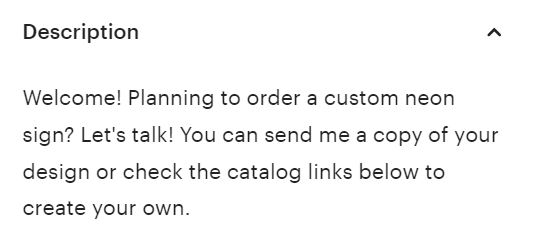
Your description should start with a brief overview of what the buyer is getting with this purchase. So for our neon light: you’re getting a custom made red neon light wall décor that can be made into any shape or design per your request.
Notice how I’ve included what would be the standout features of this listing – custom made, made into any shape or design per request – into the starter description. Make sure to highlight whatever you think makes your listing stand out in the starter description.
The next paragraph should clarify the details of the listing. Go deeper into what the customer is getting, paragraph by paragraph, then add what you’ll require from them and how the purchase will proceed.
Here you can expand on the fine details. For instance, the quality of technology used in our neon lights; how the customization will match whatever design template the buyer sends and possible use cases for the lights. The goal is to paint a picture of the value the buyer will get from the product.
Don’t forget to also hammer down on what you’ll need and any other relevant detail.
If you’ve got other similar products in your shop, it makes sense to link them in a paragraph of your listing description.
For our neon light, we could add a paragraph that says ‘check out other design styles of this same custom light’ or ‘check out our other wall décor for the perfect interior décor set.’
Etsy allows you to insert links into your description, but they must Etsy store links.
Close your description with the technical specifications of your product, if any.
Also include the packaging and shipping details.
✅ Optimizing the additional details
Etsy also allows you to create about us, store policies and frequently asked questions (FAQ) sections. Like the description page, these sections don’t actively play a role in SEO, but they’re important in improving conversions.
Creating an about us section
The about us section is where you can now bring in all the inspirational talk I asked you to skip in the description segment. Keep it fun, light and simple.
An about us section could be literally anything: it just needs to showcase your personality, passion and values. So while many people focus on so-called best about us ‘templates,’ there’s really no one size fits all as far as about us pages are concerned.
What I’ll, however, say is that the best About us pages convey the personality, passion and value message by telling a story. Don’t be scared to get artful; say it like you would when you’re asked in person, and always, always, make it personal.
The Etsy brand is about buyers interacting directly with people who make their own stuff. Don’t let your about us page come off as that of just another e-commerce store with their boilerplate we value professionalism, team spirit and what not message.
Creating a FAQ page
FAQ pages answer buyer questions before they ask them. Answered questions provide more clarity which in turn boosts trust and eventually conversions.
How do you know which buyer questions need answering the most? Answer these questions to get started:
- What are the likely confusions buyers might have?
- What popular misconceptions do people have about your product?
- Are there any differences between your product and the market standard product?
Your FAQ segment should thoroughly cover any pain points you discover from answering these questions. If you’ve already hit the ground running and are getting customers, make a note of questions you often get – the frequently asked questions – and include them in your FAQ segment.
3. Optimizing your product photos
I’ve saved what is perhaps one of the most important listing optimization you can do for the last.
Good product photos are extremely important, I can’t stress that enough. Often they’ll be the deciding point between a buyer choosing your product or that of a competitor on Etsy. Even Etsy acknowledges this:
‘In Etsy’s customer research, shoppers have told us that product photos are critical to their purchase decision. In fact, it’s their most important factor in deciding to buy, even more important than the shipping cost, customer reviews, or even the price of the item itself.’
So what makes a good product photo?
Etsy’s ‘essential types of product photos’ guide is an excellent resource for knowing what type of product photos to take. But to summarize, for each listing, you should have a:
- Studio shot which showcases your product in a background that makes it easy to see your product clearly. The general rule is white backgrounds, but for a product like our neon light, you can see how that might not work. For your product, choose any background that brings out its features with clarity.
- Lifestyle shot which basically shows your product in normal use. For our neon light, that would be a shot that shows it hanging off the wall as décor. If you sold clothing apparel, it would be a model wearing your product.
- Process shot which gives buyers a snapshot of your creation process.
- Scale shot to demonstrate the size of your product. To make a scale shot, you need a ‘comparison model,’ another item, usually something familiar that allows would-be buyers to size up your item.
- Detail shots like the name implies are there to showcase the fine details of your product – things that the buyer might not see in the overall studio shot.
- Group shot that shows multiple copies of your items together. This is actually not that essential.
- Packaging shot showing the package in which you’d ship the product to the buyer.
Now all of this might sound like a lot of work, and it really is a lot of work, but safe to say it’s something you can do yourself.
As far you’ve got a fairly good camera (good smartphone cameras work just fine) you can create all of these product photo shots on a good Saturday afternoon. Check out this guide to Etsy product photography for more information.
4. Using reviews as a booster
I already talked about how Etsy uses reviews to gauge the quality of your service delivery. Reviews also induce buyers to trust your product/service more, but how can you pull in reviews, especially when you’re just starting?
Leveraging family and friends for reviews
If you’re a newbie seller on Etsy, one of the best ways to get those reviews rolling in is to promote your product/service to your family and friends.
Share your listing URL to your Facebook, Twitter, Instagram, whatever social media you use and try to get people around you to buy. They’re more likely to buy and leave a positive review.
If you’ve been selling offline before and have a market, however small, redirect your offline customers to buy the same product from Etsy. Yes, you lose the commission Etsy takes from each sale, but you also get a priceless review that can boost your listing up the listing pages.
For established buyers, more reviews mean more trust, more positive signals to Etsy and eventually higher rankings. Etsy does its part to remind sellers about reviews once they receive their item, but you can take it up one notch by adding a complementary thank you card or note in their packages.
Do not, however, request for reviews in exchange for anything; that’s against Etsy’s TOS and doing so can get you sanctioned.
Remember also that positive reviews come from excellent service delivery. Strive to do the most for your customers and always attend to complaints and questions promptly and cautiously. Before most buyers leave a negative review, they communicate with sellers first to seek redress.
5. Updating your store and listings
To capitalize on the recency ranking factor, it makes sense to periodical update your store and product listings. Follow these guidelines.
- For listings pulling in significant sales, you don’t want to perform any updates or modifications. At best, add a few more photos and maybe throw in a discount or bonus in your listing description. Leave the title, tags, attributes and categories unchanged.
- For new listing still picking up steam with one or few odd sales, tweaking your title and tags can provide a boost. Tweaks should be centered around keywords from your keyword research. If you’re confident, the category and attribute tags are well-grounded leave them unedited.
- For new listings yet to make any sale, feel free to tweak everything, including the title, tags, attributes, and category, as well as the listing description. Again your tweaks should revolve around the keywords from your keyword research.
Whenever you make a tweak, it’s important that you give time to gauge the effect of the tweak before making another. Usually, this time should be 2 – 3 days.
Once you make a tweak and notice an uptrend, however small, you should leave the new listing update in place until you’re sure there’s a stagnation or downtrend. What I mean is if your listing performance is trending upwards, however slow, it’s better to leave the new update in place.
6. Dominating through promotions
It’s possible to tick all the SEO checkboxes and still not gain any traction, especially if your product falls under the ‘competitive niche.’
In those cases, to gain headwind, you need to work outside the Etsy box. Specifically, you need to promote your product to prospective buyers off the Etsy platform.
Here’s how to do it.
You have two options:
- Either use your existing social media accounts to promote your Etsy products
- Or create a new dedicated account for social media promotions
The first option is better if you already have active followership on social media.
If you don’t, then it’s better to create new social media handles for your Etsy shop.
Social media to focus on
The actual social media platforms to focus on will depend mostly on the type of product you sell on Etsy. That said, at the very least, you need to have a presence on Facebook, Instagram and Twitter.
The strategy
On each platform, the goal is to drive engagement with your Etsy brand. You can do that by:
- Jumping on trends
- Creating unique content that can engage

With the first option, your job is to search for social media trends related to your Etsy shop and products. For our neon light product, an example of social media trends and hashtags will be interior décor or festive season décor.
Once you’re done finding trends and hashtags, you need to make social media posts with a caption with these hashtags and trend keywords included.
This approach is particularly effective on Twitter and Instagram, but it’s important that you don’t overdo it else, you risk getting shadowbanned on account of spamming. One post every day is enough; at most, two posts.
Your post should contain an image or video content. Video is better for driving engagement, and it could be a short video of you holding the product.
Try not to include links in your posts but instead include wording that directs people to your social media homepage with your Etsy store link on your profile. Again this is to prevent your post from getting marked as spam.
The second option of creating unique content is a little bit tougher to orchestrate since it requires posting unique, genuinely interesting content about your product. Rather than jumping on trends, this method requires posting engaging and entertaining content that people will find worthwhile to engage with.
This will require creating a social media content plan and a posting schedule. Sounds like too much work? Check out my guide to Etsy promotions for more information on how to go about it without stressing yourself out.
✅ Paid promotions
If you’d rather just sit down, relax and not go through the stress of running your own promotion, you can pay for a Etsy promotion campaign. There are two ways to do this:
Etsy native ads
Which allows you to pay for ads on the Etsy platform, so your listing shows up in Etsy search for specific keywords.
Off-site ads
With off-site ads, you can showcase your products to would-be buyers on social media platforms like Facebook, Twitter and Instagram, as well as search engines like Bing and Google.
In each case, you bid for an ad slot, and your ads get presented to people who’re most likely to convert based on your specified ad setting.
I wouldn’t recommend taking on paid ads yourself if you’ve never done it before. Rather you should consult with professional ad specialists who understand the workings of these ad platforms and can tailor an ad for maximum conversions at minimum spend.
Rounding up
In this guide, we’ve mostly focused on the direct parts of SEO and how they affect your performance on Etsy. At the end of the day, Etsy just wants to drive more sales, and one of the core drivers of more sales is an excellent product.
You might notice some sellers on Etsy top of rankings who don’t have killer descriptions or five pages long FAQ sections set-up. Most times, the differentiating factor is the quality of their product.
For you, it’s important that whatever you sell is both likeable and well built. Likeable in the sense that it’s something buyers expect to see on Etsy. When you have a killer product, Etsy SEO becomes all the more easier to set up and scale.
If you ever need more help, feel free to check out my other Etsy guides and resources for contracting the tougher bits of Etsy SEO to freelancers.
